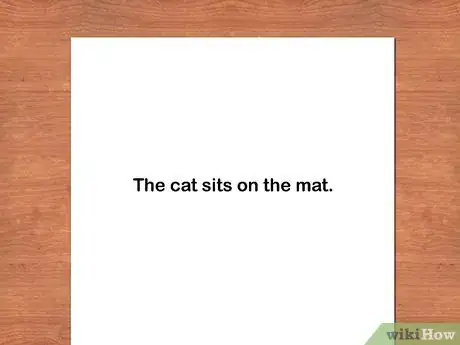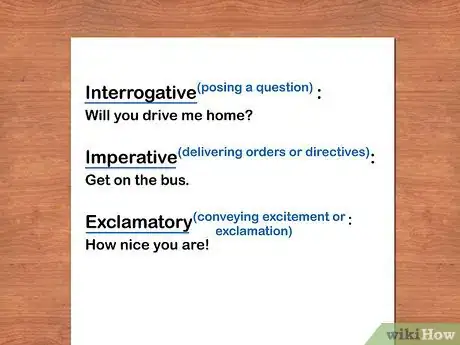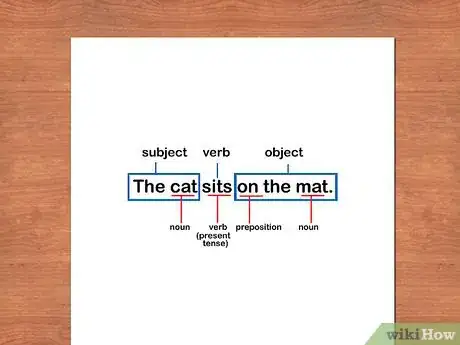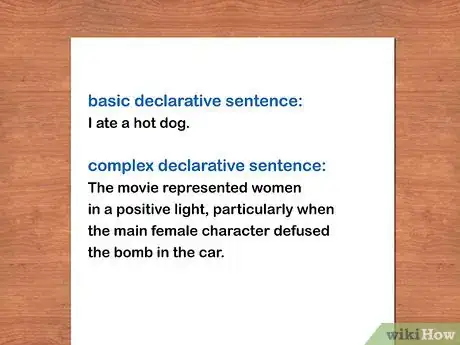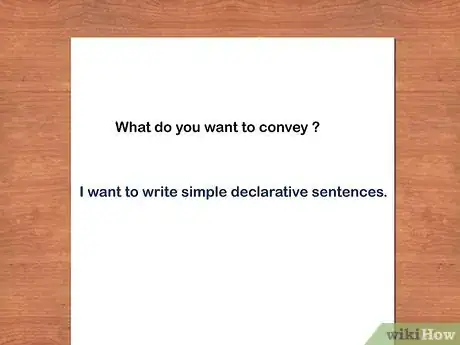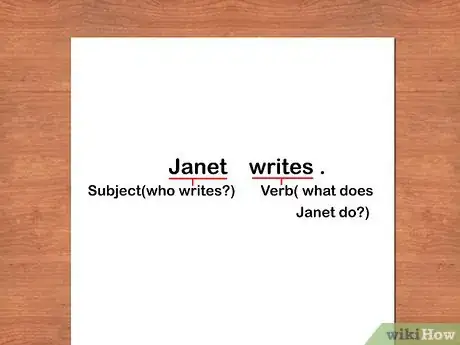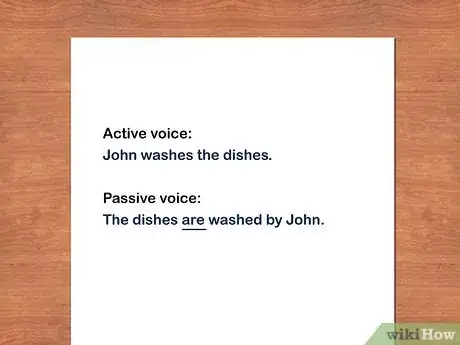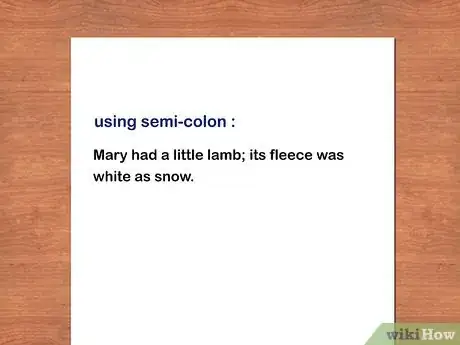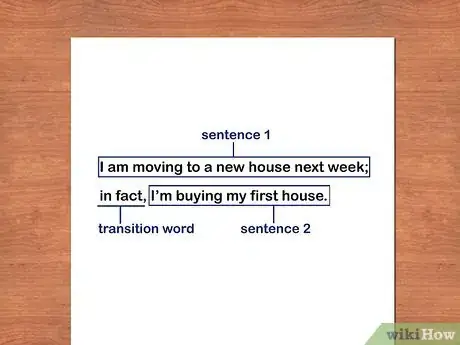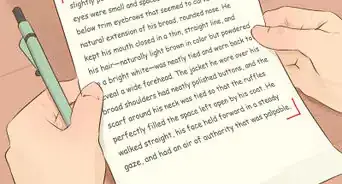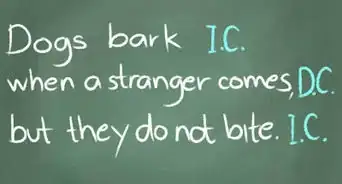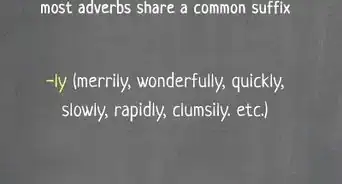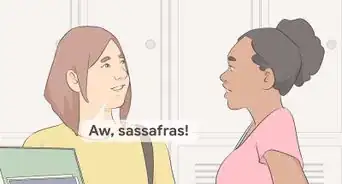This article was co-authored by Mary Erickson, PhD. Mary Erickson is a Visiting Assistant Professor at Western Washington University. Mary received her PhD in Communication and Society from the University of Oregon in 2011. She is a member of the Modern Language Association, the National Communication Association, and the Society for Cinema and Media Studies.
This article has been viewed 65,901 times.
Knowing how to communicate information is a skill that will prove valuable in both writing and speaking. When you need to convey an idea, make a straightforward statement to your audience by using a declarative sentence. This type of sentence can be reduced to a basic idea, based on a single subject and predicate. It can also be complex, with multiple clauses and descriptions. Once you recognize a declarative sentence, you can choose how much information you'd like to convey by writing simple or complex sentences.
Steps
Recognizing a Declarative Sentence
-
1Identify a declarative sentence. A declarative sentence is a statement made directly by the speaker to the listener. It conveys information directly. For example, the following are examples of declarative sentences:
- The cat sits on the mat.
- I started to laugh.
- That cloud looks like a fish.
-
2Distinguish different types of sentences. Declarative sentences are different from other types of sentences. In order to better understand grammar and writing, learn to identify other common types of sentences. Some of these include:[1]
- Interrogative: This type of sentence is used to pose a question (e.g., “Will you drive me home?”)
- Imperative: This type of sentence is used for delivering orders or directives (e.g., “Get on the bus.”)
- Exclamatory: This type of sentence is expressed in such a way as to convey excitement or exclamation. It is usually indicated by the punctuation at the end of the sentence, typically in the form of an exclamation point (e.g., “How nice you are!”).
Advertisement -
3Understand the parts of a declarative sentence. At its core, the declarative sentence is very basic. There is a noun and a verb in the sentence. The sentence can have other elements, such as adjectives, adverbs and other words. But the simplest form is just a noun and verb.
- The verb in a declarative sentence can be in any tense form (present, future, past, etc.).
-
4Don't get confused by the length of the sentence. Declarative sentences can be any length. They can convey very basic, simple information (such as: “I ate a hot dog.”), or they can convey lots of complex information (such as: “The movie represented women in a positive light, particularly when the main female character defused the bomb in the car.”).
- The sentence is declarative if it makes a statement, rather than asking a question, giving an order, or making an exclamation.
Writing Simple Declarative Sentences
-
1Determine the idea you want to convey. A simple declarative sentence conveys information directly. Figure out the essence of what you want to communicate.[2] How will you state this information in a simple way? When writing a simple declarative sentence, use one idea and eliminate excess phrases and words.
-
2Choose your subject and predicate. A declarative sentence is made up of two basic elements: the noun, or subject, and the verb, or predicate. Convey information directly and simply by choosing the most basic information. Some examples include:
- “Jane eats.”
- ”The cat meows.”
- ”The car moves.”
-
3Use the active voice. The active voice is a style that directly conveys information. It uses descriptive verbs that gives the reader substantial information in few words.[3]
- In contrast, the passive voice relies on words like “is” or “was” in a way that conveys information less directly. You can still use the passive voice for a declarative sentence. But the whole point of a declarative sentence is to be direct and to the point, so the active voice is preferred.
-
4Use proper punctuation. One way to recognize different types of sentences is to examine the punctuation at the end of the sentence. A declarative sentence uses a period at the end of the sentence. In contrast, an interrogative sentence typically uses a question mark at the end of the sentence. An exclamatory sentence uses an exclamation mark.
Writing Complex Declarative Sentences
-
1Use “and” to join two statements. A declarative sentence doesn't need to be a simple sentence. Create a more complex statement that conveys more information. Build upon one idea by using the word “and” to join it with more information. Include a comma before “and.”[4]
- For example: “I caught a fish, and I threw it back into the water.”
-
2Use a semi-colon to create a more complex sentence. Another way to build upon the idea in your declarative sentence is to use a semi-colon. This creates another clause in your sentence, or a related idea that contributes more information to the message you're conveying.[5]
- For example, “Mary had a little lamb; its fleece was white as snow.”
-
3Link two ideas with a transition word. A transition word, known as a conjunction, links two ideas that are related. They can be used to build upon an idea, or they can be used to contrast an idea. Examples of transition words or phrases include: “however,” “in fact,” “nevertheless,” “moreover,” and “besides.”
- For example: “I am moving to a new house next week; in fact, I'm buying my first house.”
- “I've gotten used to sleeping outside when I go camping; however, I really like sleeping in a feather bed.”
Community Q&A
-
QuestionIs "I want to become a writer" a declarative sentence?
 KY_GirlatHeartCommunity AnswerIt most certainly is! Just be sure to capitalize the "I," as it is the first word in the sentence and every "I" should be capitalized, and be sure to put a period after writer! The sentence would appear as follows: I want to become a writer.
KY_GirlatHeartCommunity AnswerIt most certainly is! Just be sure to capitalize the "I," as it is the first word in the sentence and every "I" should be capitalized, and be sure to put a period after writer! The sentence would appear as follows: I want to become a writer. -
QuestionWrite five declarative sentences?
 KY_GirlatHeartCommunity Answer1) The tiger paced about in the darkness, waiting to strike any unsuspecting passerby. 2) I bought a new fishing pole today. 3) This coffee is a bit too cold for my taste. 4) Susan has left for work already. 5) Miss Arnold will pass out the test papers.
KY_GirlatHeartCommunity Answer1) The tiger paced about in the darkness, waiting to strike any unsuspecting passerby. 2) I bought a new fishing pole today. 3) This coffee is a bit too cold for my taste. 4) Susan has left for work already. 5) Miss Arnold will pass out the test papers.
References
- ↑ http://www.ucl.ac.uk/internet-grammar/clauses/decl.htm
- ↑ http://www.sentencemaster.ca/howtowritesentences3.html
- ↑ http://blogs.wp.missouristate.edu/writinglab/writing-process/active-and-passive-voice/
- ↑ http://www.k12reader.com/declarative-sentences-are-the-most-common-type%E2%80%A6and-with-good-reason/
- ↑ http://www.k12reader.com/declarative-sentences-are-the-most-common-type%E2%80%A6and-with-good-reason/
